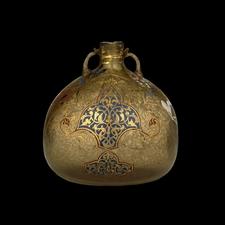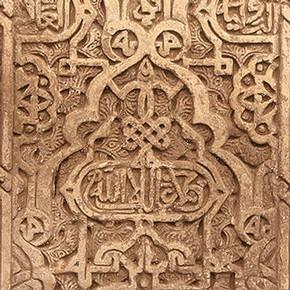To begin with, it is imperative to note that various forms of Islamic art have been used to display both the past and modern Islamic culture. In the British Museum, Islamic art has been vastly displayed in room 34. In fact, this room has been nicknamed the Islamic world. The room offers the opportunity to learn both the ancient and contemporary Islamic culture due to myriads of exhibits that are depicting Islamic art. The exhibits have also been used to explore science, calligraphy, art, and belief systems associated with the Islamic religion.
The chronological history in the development of Islamic art has been featured both in the British Museum and the Victoria and Albert Museum through various displays of scientific instruments, metalwork, calligraphic decoration, and glass mosque lamps.
The Pilgrim bottle in the British Museum
The aesthetic value of the bottle was improved by engraving several decorations depicting aspects such as arabesques, animated scrolls, musicians, and horsemen. In terms of the shape, one of its sides is relatively flat while the other side is round in shape. It largely resembles ceramic bottles that are unglazed or flasks made of leather. It has no resemblance to objects made of metal or glass. The artwork dates back between AD 1330 and1350. Islamic historians believe that it was largely used during the pilgrimage seasons even though it was made of glass. It implies that great caution was exercised during its usage bearing in mind that glass is brittle and can easily break. As part of the precautionary measures, the pilgrim bottle used to be carried in a container made of leather. It is highly likely that this bottle was used as a luxury object and therefore, could be given out as a special form of a gift.
Various types of colors were used to decorate the enamel bottle. Some of the colors included grayish-black, mauve, pink, yellow, pale green, blue, white, and red. It comprised almost all the basic types of colors. The flattened side of the bottle was decorated using vegetal scrolls laced with eight-lobbed flower and 11-point rosette.
In addition, a lobbed motif with four sides was used to add decorations on the rounded side of the bottle. The decorations were made using specific geometric shapes alongside scrolls that were keenly attached to depict the heads of birds, other animals, and human beings.
A horseman has been engraved on the left side of the rounded side of the bottle. The man is holding a spear ready to kill an animal. The man is putting on a hat that has the shape of a cone, and his head is surrounded by a halo. He has a lot of beards as well. A female harp player has been positioned below the image of the above man. The female character is putting on a long tunic and a veil. Moreover, there is a lion being killed by a horseman towards the narrow end of the bottle. The man is putting on boots and a long coat. He is also wearing a halo. Below this impression, there is a figure of a man who is drinking something using a beaker. He is in a sitting position with legs crossed. The sleeves of his tunic have been decorated with tires bands.
It is pertinent to note that Christian iconography is similar to the two horsemen depicted on the sides of the pilgrim bottle. In addition, impressions depicted in Islamic art are quite similar to figures that have been represented in the medallions. Judging from how the motifs have been mixed, it is apparent that the creator of these decorations was either a Christian who was appreciating Islamic art or an Islamic artist who was acquainted with images drawn from a Christian background. The figure below shows the pilgrim bottle.

Nasrid plasterwork in the Victoria and Albert Museum
Nasrid plasterwork is one of the outstanding Islamic artworks displayed in the Victoria and Albert Museum. There are vibrant palettes of pigments that have been used to improve the aesthetic value of this piece of art. Moreover, intricate ornaments vaults, ceilings, arches were decorated using the Nasrid plasterwork style. This type of plasterwork was used during the ancient Islamic culture in Spain. It is vital to note that there were different types of decorative styles that were used to develop the Nasrid plasterwork. For instance, the most common piece made use of the Kufi style of writing. This was a unique scripting language that was used to represent ideas on various pieces of art. Most of the Nasrid plasterworks were used in Granada’s Alhambra Palace. The figure below shows one of the artistic fragments of the Nasrid plasterwork being exhibited at the Victoria and Albert Museum.

From the above piece, it can be noted that geometric Lazo is quite distinctive. There are regular patterns made up if square grids and pointed stars. Besides, Nashkid-Thuluth calligraphy is a common element in this plasterwork.
Comparisons
From the two forms of Islamic art, it can be noted that each one of them was used for different purposes. The pilgrim bottle was largely used as a gift and could as well be used to carry liquid substances. On the other hand, the Nasrid plasterwork was solely meant for decorating surfaces in palaces and other royal buildings. The display of the pilgrim bottle looks quite impressive since it is a single piece of art that is strategically positioned compared to the Nasrid plasterwork that is made of several fragments. These fragments cannot be understood easily by new visitors in the museum due to complex calligraphy used to decorate them.